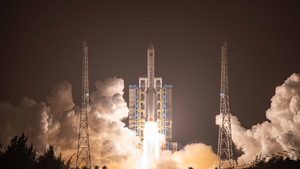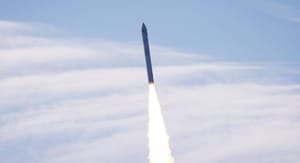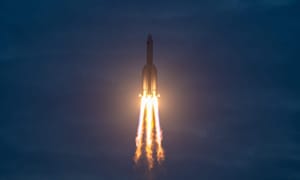
On the 14th and 15th of December 2023, China launched a Long March 2F/G and a Long March 5 for two largely secretive missions.
The Long March 2F/G launched from Launch Area 4 at the Jiuquan Satellite Launch Center, in northern China, on the 14th at 14:11 UTC, this liftoff time may not be accurate due to a lack of information available. The Long March 2F/G is believed to have placed its payload into low Earth orbit.
The Long March 5 lifted off from LC-101 at the Wenchang Space Launch Site, located on the island of Hainan in southern China, on the 15th at 13:41 UTC. The spacecraft atop of the Long March 5 is believed to have separated from the rocket after being placed into geosynchronous transfer orbit.
What was the payload of the Long March 2F/G?
The payload launched from the Jiuquan Satellite Launch Center on the 14th is believed to be China's reusable space vehicle for its third flight. The reusable space vehicle is believed to be a spaceplane similar to the Boeing X-37B operated by the United States Space Force.
According to Xinhua News, the spaceplane's mission is as follows:
"During the in-orbit operation, the spacecraft will conduct verifications for reusable technologies and space science experiments to provide technical support for the peaceful use of space."
China Daily and CGTN also reported this as the spacecraft's mission.

According to international observers, the spaceplane is in a 333 by 347 kilometer orbit on a fifty-degree inclination with each orbit taking ninety-two minutes. This orbital inclination allows the spaceplane to orbit as far south as New Zealand's southern island and as far north as the Canadian island of Newfoundland.
The mission length is currently unknown but the spaceplane could spend a few hundred days on orbit.
The previous two missions were both launched on the same rocket at the Jiuquan Satellite Launch Center. The first launch is believed to have occurred on the 4th of September 2020 before returning to Earth two days later. The second launch occurred on the 4th of August 2022 spending two-hundred and seventy-six days on orbit before returning to Earth on the 8th of May 2023.
What was the payload of the Long March 5?
The payload launched from the Wenchang Space Launch Site on the 15th was a Yaogan 41 optical remote-sensing satellite. The launch vehicle is believed to have placed Yaogan 41 into a geosynchronous transfer orbit where it will eventually be raised into a geostationary orbit.
The initial orbit after liftoff is believed to have been a 176 by 35,812 kilometer orbit on a nineteen point five degree inclination. This inclination allows the satellite to orbit as far north as southern Mexico and as far south as Paraguay.

According to China Daily, the following is the stated purpose of the Yaogan satellite fleet including Yaogan 41:
"Yaogan 41 is the newest in China's fleet of remote-sensing satellites, and will be used to obtain data for land resources surveying, agricultural yield forecasting, environmental monitoring, and disaster prevention and relief." – "China has so far sent more than 300 civilian remote-sensing satellites into orbit. The Yaogan family is the largest fleet of remote-sensing spacecraft in the country, and their data has been widely used by governments, public service sectors and businesses."
This launch also featured a new 18.5-meter fairing, which is six meters longer than the nations record holder also flown on the Long March 5. The new fairing also keeps the same diameter of the rocket at 5.2 meters wide.
What is the Long March 2F/G?
The Long March 2F/G is part of the Long March 2 launch vehicle family and part of the larger Long March series of rockets. The rocket has two stages, including four boosters, all burning Dinitrogen Tetroxide and Unsymmetrical Dimethylhydrazine.
There is also the Long March 2F/T which is identical to the 2F/G in all but it's fairing. The 2F/T is currently used to launch China's reusable space vehicle.
The Long March 2F/G can place up to 8,400 kilograms into low Earth orbit.

The four boosters are powered by one YF-20B each generating 83 tons of thrust each burning Dinitrogen Tetroxide and Unsymmetrical Dimethylhydrazine for two minutes and eight seconds. The four boosters have a combined thrust of 332 tons of thrust. The first stage is powered by four YF-20B generating a combined 332 tons of thrust burning Dinitrogen Tetroxide and Unsymmetrical Dimethylhydrazine for two minutes and forty-six seconds. The second stage is powered by one YF-24B generating 85 tons of thrust burning Dinitrogen Tetroxide and Unsymmetrical Dimethylhydrazine for five minutes.
What is the Long March 5?
The Long March 5 launch vehicle is part of the Long March series of rockets. It currently has one variant also flying called the Long March 5B, the 5B is largely the same as the Long March 5 but flies without its second stage. Both the Long March 5 and 5B burn liquid hydrogen and liquid oxygen in its first stage. The Long March 5 burns liquid hydrogen and liquid oxygen in its second stage. Both the Long March 5 and 5B burn rocket-grade kerosene and liquid oxygen in their boosters.
The Long March 5 rockets can place up to 25,000 kilograms into low Earth orbit, 14,000 kilograms into geosynchronous transfer orbit, up to 9,400 kilograms on a trans-lunar injection, 5,100 kilograms directly into geostationary orbit, and up to 15,000 kilograms into sun-synchronous orbit.

The four boosters are powered by two YF-100 engines each generating 245 tons of thrust each burning rocket-grade kerosene and liquid oxygen for two minutes and fifty-three seconds. The four boosters have a combined thrust of 979 tons of thrust. The first stage is powered by two YF-77 engines generating 143 tons of thrust burning liquid hydrogen and liquid oxygen for eight minutes and twelve seconds. The second stage is powered by two YF-75D engines generating 18 tons of thrust burning liquid hydrogen and liquid oxygen for eleven minutes and forty seconds.



